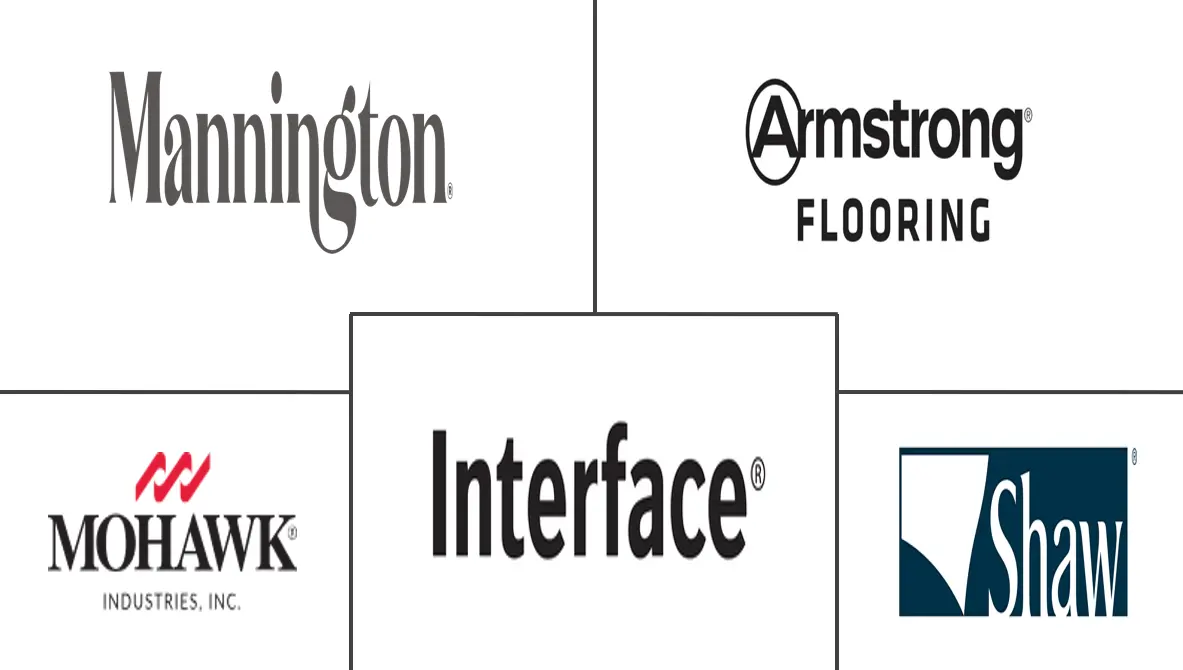Market Size of United States Floor Covering Industry

| Study Period | 2020 - 2029 |
| Base Year For Estimation | 2023 |
| Market Size (2024) | USD 42.68 Billion |
| Market Size (2029) | USD 58.58 Billion |
| CAGR (2024 - 2029) | 6.54 % |
| Market Concentration | Low |
Major Players
*Disclaimer: Major Players sorted in no particular order |
United States Floor Covering Market Analysis
The United States Floor Covering Market size is estimated at USD 42.68 billion in 2024, and is expected to reach USD 58.58 billion by 2029, growing at a CAGR of 6.54% during the forecast period (2024-2029).
The floor covering market in the United States is a rapidly growing industry comprising all types of flooring products, such as carpets, rugs, tiles, vinyl, wood, and laminates. The market is driven by continuous infrastructure development and growing construction activities in residential and commercial sectors. In recent years, the demand for sustainable and environmentally friendly flooring options has also increased, leading to the popularity of products made from renewable materials such as bamboo, cork, and linoleum.
There has been a strong trend toward using luxury vinyl tiles and planks, which offer a more realistic look and feel of wood and stone at a lower cost. Moreover, the deployment of advanced manufacturing technologies has led to the production of high-quality products with enhanced durability, safety, and sustainability features. Overall, the US floor-covering market is a dynamic and evolving industry driven by construction activity, home improvement trends, changing consumer preferences, technological advancements, and shifts in retail channels.
United States Floor Covering Industry Segmentation
Flooring and carpets play a crucial role in households and find applications in various other settings. Flooring and carpets are made of wood, polymer staple fibers, carpets and rugs, vinyl sheets, and ceramic tiles.
The US floor covering market is segmented by product, end user, and distribution channel. By product, the market is segmented into carpet and rugs, resilient flooring, and non-resilent flooring. By distribution channel, the market is segmented into home centers, specialty stores, flagship stores, and online stores. By end user, the market is segmented into commercial and residential. The report also offers market size and forecasts in value (USD) for all the above segments.
| By Product | ||||||
| Carpet and Rugs | ||||||
| ||||||
|
| By Distribution Channel | |
| Flagship Stores | |
| Specialty Stores | |
| Home Centers | |
| Online Stores |
| By End User | |
| Residential | |
| Commercial |
United States Floor Covering Market Size Summary
The US floor covering market is experiencing growth driven by increased consumer confidence and a rise in single-family home construction. The market's expansion is supported by the building and construction industries, although challenges such as raw material price volatility persist. The residential improvement sector has seen significant spending, benefiting the floor covering industry. Digital printing technology adoption by manufacturers is helping reduce operational costs and environmental impact. Despite the initial setbacks caused by the COVID-19 pandemic, which disrupted supply chains and reduced demand, the market is expected to recover and gain long-term momentum. Urbanization and rapid infrastructural developments are further boosting the demand for flooring products, with product innovation and customization playing key roles in market growth.
Vinyl flooring is gaining popularity due to its cost-effectiveness, durability, and versatility, making it suitable for various applications, including residential and non-residential settings. The market for vinyl flooring is bolstered by urbanization, rising disposable incomes, and a growing interest in home décor. Major players dominate the market, but technological advancements and product innovations are allowing mid-size and smaller companies to expand their presence. The introduction of new technologies, such as Välinge Innovation's 5G and Threespine click technologies, and product lines like MD PRO's luxury vinyl floor coverings, are contributing to the market's promising future. These developments highlight the ongoing evolution and potential growth within the US floor covering market.
United States Floor Covering Market Size - Table of Contents
-
1. MARKET DYNAMICS AND INSIGHTS
-
1.1 Market Overview
-
1.2 Market Drivers
-
1.2.1 Growing Renovation and Construction Activities
-
1.2.2 Rising Demand for Eco-Friendly and Sustainable Flooring
-
-
1.3 Market Restraints
-
1.3.1 Stringent Government Regulations on Emissions Associated with Constructing of Flooring
-
1.3.2 High Prices of Raw Materials Used in the Manufacturing of Flooring Products
-
-
1.4 Market Opportunities
-
1.4.1 Adoption of Virtual and Augmented Reality Technology
-
1.4.2 Rise of Digital Platforms and E-commerce
-
-
1.5 Value Chain Analysis
-
1.6 Industry Attractiveness: Porter's Five Forces Analysis
-
1.6.1 Threat of New Entrants
-
1.6.2 Bargaining Power of Buyers
-
1.6.3 Bargaining Power of Suppliers
-
1.6.4 Threat of Substitutes
-
1.6.5 Intensity of Competitive Rivalry
-
-
1.7 Insights into Technological Advancements in the Industry
-
1.8 Impact of COVID-19 on the Market
-
-
2. MARKET SEGMENTATION
-
2.1 By Product
-
2.1.1 Carpet and Rugs
-
2.1.2 Resilent Flooring
-
2.1.2.1 Vinyl Flooring
-
2.1.2.2 Other Resilient Flooring
-
-
2.1.3 Non-resilent Flooring
-
2.1.3.1 Wood Flooring
-
2.1.3.2 Ceramic Flooring
-
2.1.3.3 Laminate Flooring
-
2.1.3.4 Stone Flooring
-
-
-
2.2 By Distribution Channel
-
2.2.1 Flagship Stores
-
2.2.2 Specialty Stores
-
2.2.3 Home Centers
-
2.2.4 Online Stores
-
-
2.3 By End User
-
2.3.1 Residential
-
2.3.2 Commercial
-
-
United States Floor Covering Market Size FAQs
How big is the United States Floor Covering Market?
The United States Floor Covering Market size is expected to reach USD 42.68 billion in 2024 and grow at a CAGR of 6.54% to reach USD 58.58 billion by 2029.
What is the current United States Floor Covering Market size?
In 2024, the United States Floor Covering Market size is expected to reach USD 42.68 billion.

